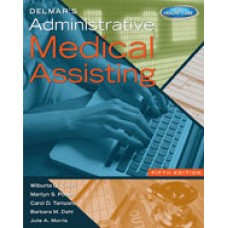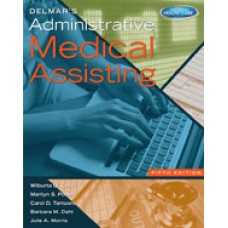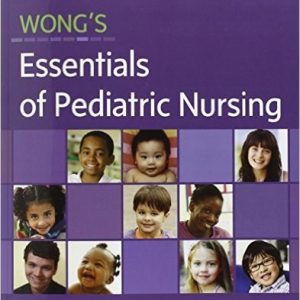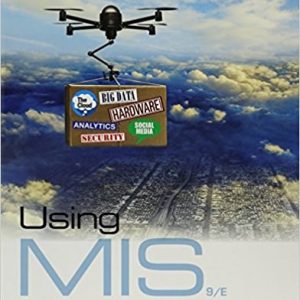This is completed downloadable of Test Bank for Delmars Administrative Medical Assisting, 5th Edition

Product Details:
- ISBN-10 : 1133603017
- ISBN-13 : 978-1133603016
- Author:
Study more effectively and improve your performance at exam time with this comprehensive guide. Written to work hand-in hand with DELMAR’S COMPREHENSIVE MEDICAL ASSISTING: ADMINISTRATIVE AND CLINICAL COMPETENCIES, 5th Edition, this user-friendly guide includes a wide variety of learning tools to help you master the key concepts of the course.
Table of Content:
- Section I: General Procedures
- Unit I: Introduction to Medical Assisting and Health Professions
- Ch 1: The Medical Assisting Profession
- Historical Perspective of the Profession
- Career Opportunities
- Education of the Medical Assistant
- Accreditation of Medical Assisting Programs
- Attributes of a Medical Assistant Professional
- American Association of Medical Assistants
- American Medical Technologists
- Other Certification
- Regulation of Health Care Providers
- Ch 2: Health Care Settings and the Health Care Team
- Ambulatory Health Care Settings
- The Health Care Team
- Allied Health Professionals and Their Roles
- The Value of the Medical Assistant to the Health Care Team
- Ch 3: History of Medicine
- Cultural Heritage in Medicine
- Medical Specialists in History
- History of Medical Education
- History of Attitudes toward Illness
- Historical Medical Treatments
- Significant Contributions to Medicine
- Frontiers in Medicine
- Unit II: The Therapeutic Approach
- Ch 4: Coping Skills for the Medical Assistant
- What is Stress?
- Factors Causing Stress
- Effect of Prolonged Stress-Burnout
- General Stress Management Techniques
- Goal Setting as a Stress Reliever
- Ch 5: Therapeutic Communication Skills
- Importance of Communication
- The Communication Cycle
- Types of Communication
- Factors Affecting Therapeutic Communication
- Establishing Multicultural Communication
- Therapeutic Communication in Action
- Community Resources
- Ch 6: The Therapeutic Approach to the Patient with a Life-Threatening Illness
- Life-Threatening Illness
- Choices in Life-Threatening Illness
- The Range of Psychological Suffering
- The Therapeutic Response to the Patient with HIV/AIDS
- The Therapeutic Response to the Patient with Cancer
- The Therapeutic Response to the Patient with End-Stage Renal Disease
- The Stages of Grief
- The Challenge for the Medical Assistant
- Unit III: Responsible Medical Practice
- Ch 7: Legal Considerations
- Sources of Law
- Administrative Law
- Contract Law
- Tort Law
- Informed Consent
- Risk Management
- Civil Litigation Process
- Statute of Limitations
- Public Duties
- Advance Directives
- Ch 8: Ethical Considerations
- Ethics
- Keys to the AAMA Code of Ethics
- Ethical Guidelines for Health Care Providers
- Bioethics
- Ch 9: Emergency Procedures and First Aid
- Recognizing an Emergency
- Preparing for an Emergency
- Common Emergencies
- Breathing Emergencies and Cardiac Arrest
- Safety and Emergency Practices
- Section II: Administrative Procedures
- Unit IV: Integrated Administrative Procedures
- Ch 10: Creating the Facility Environment
- Creating a Welcoming Environment
- The Reception Area
- Clinic Design and Environment
- Legal Compliance in the Facility
- Safety
- Opening the Facility
- Closing the Facility
- The Future Environment for Ambulatory Care
- Ch 11: Computers in the Ambulatory Care Setting
- The Computer System
- Components of a Computer System
- Cloud Computing
- Computer Maintenance by Clinic Personnel
- Use of Computers in the Medical Clinic
- Design Considerations for a Computerized Medical Clinic
- Ergonomics
- Patient Confidentiality in the Computerized Medical Clinic
- HIPAA Standards for Safeguarding Protected Health Information (PHI)
- Professionalism in the Computerized Medical Clinic
- Ch 12: Telecommunications
- Telecommunications in the Electronic Health Record Environment
- Basic Telephone Techniques
- Routing Calls in the Medical Clinic
- Telephone Documentation
- Using Telephone Directories
- Placing Outgoing Calls
- Placing Long-Distance Calls
- Legal and Ethical Considerations
- HIPAA Guidelines for Telephone Communications
- Americans with Disabilities Act (ADA)
- Telephone Technology
- Professionalism in Telecommunications
- Ch 13: Patient Scheduling
- Tailoring the Scheduling System
- Scheduling Styles
- Analyzing Patient Flow
- Legal Issues
- Interpersonal Skills
- Guidelines for Scheduling Appointments
- Scheduling Software and Materials
- Inpatient and Outpatient Admissions Procedures
- Ch 14: Medical Records Management
- The Purpose of Medical Records
- Ownership of Medical Records
- Authorization to Release Information
- Manual or Electronic Medical Records
- The Importance of Accurate Medical Records
- Types of Medical Records
- Equipment and Supplies
- Basic Rules for Filing
- Steps for Filing Medical Documentation in Patient Files
- Filing Techniques and Common Filing Systems
- Filing Procedures
- Correspondence
- Electronic Medical Records
- Ch 15: Written Communications
- Composing Correspondence
- Components of a Business Letter
- Letter Styles
- Supplies for Written Communication
- Other Types of Correspondence
- Processing Incoming and Outgoing Mail
- Legal and Ethical Issues
- Ch 16: Medical Documents
- The Changing Role of Medical Transcription
- Confidentiality and Legal Issues
- Types of Medical Documents
- Turnaround Time and Productivity
- Medical Transcription as a Career
- Unit V: Managing Facility Finances
- Ch 17: Medical Insurance
- Understanding the Role of Health Insurance
- Medical Insurance Terminology
- Types of Medical Insurance Coverage
- Screening for Insurance
- Referrals and Authorizations
- Determining Fee Schedules
- Legal and Ethical Issues
- Professional Careers in Insurance
- Ch 18: Medical Insurance Coding
- Insurance Coding Systems Overview
- Coding of Medical Procedures
- Healthcare Common Procedure Coding System (HCPCS)
- Coding of Medical Diagnoses
- Coding Accuracy
- Coding the Claim Form
- Third-Party Guidelines
- Completing the CMS-1500 (08-05)
- Benefits of Submitting Claims Electronically
- Managing the Claims Process
- The Insurance Carrier’s Role
- Legal and Ethical Issues
- Ch 19: Daily Financial Practices
- Patient Fees
- Credit Arrangements
- The Bookkeeping Function
- Recording Patient Transactions
- Banking Procedures
- Purchasing Supplies and Equipment
- Petty Cash
- Ch 20: Billing and Collections
- Billing Procedures
- Credit and Collection Policies
- Payment at Time of Service
- Truth-In-Lending Act
- Components of a Complete Statement
- Monthly and Cycle Billing
- Past-Due Accounts
- Collection Process
- Aging Accounts
- Collection Techniques
- Use of an Outside Collection Agency
- Use of Small Claims Court
- Special Collection Situations
- Statute of Limitations
- Maintain a Professional Attitude
- Ch 21: Accounting Practices
- Bookkeeping and Accounting Systems
- Day-End Summary
- Accounts Receivable Trial Balance
- Accounts Payable
- The Accounting Function
- Cost Analysis
- Financial Records
- Useful Financial Data
- Legal and Ethical Guidelines
- Section III: Clinical Procedures
- Unit VI: Integrated Clinical Procedures
- Ch 22: Infection Control and Medical Asepsis
- Impact of Infectious Diseases
- The Process of Infection
- Infection Cycle
- The Body’s Defense Mechanisms for Fighting Infection and Disease
- Stages of Infectious Diseases
- Disease Transmission
- Human Immunodeficiency Virus and Hepatitis B and C
- Reporting Infectious Disease
- Standard Precautions
- OSHA Regulations
- OSHA Regulations and Students
- Principles of Infection Control
- Medical Asepsis
- Bioterrorism
- Ch 23: The Patient History and Documentation
- The Purpose of the Medical History
- Preparing for the Patient
- A Cross-Cultural Model
- Patient Information Forms
- Computerized Health History
- The Patient Intake Interview
- Communication across the Life Span
- The Medical Health History
- The Patient Record and Its Importance
- Methods of Charting/Documentation
- Electronic Medical Records (EMR)
- Rules of Charting
- Ch 24: Vital Signs and Measurements
- The Importance of Accuracy
- Temperature
- Pulse
- Respiration
- Blood Pressure
- Height and Weight
- Measuring Chest Circumference
- Ch 25: The Physical Examination
- Methods of Examination
- Positioning and Draping
- Equipment and Supplies for the Physical Examination
- Basic Components of a Physical Examination
- The Physical Examination Sequence
- After the Examination
- Unit VII: Assisting with Specialty Examinations and Procedures
- Ch 26: Obstetrics and Gynecology
- Obstetrics
- Gynecology
- Ch 27: Pediatrics
- What is Pediatrics?
- Theories of Growth and Development
- Growth Patterns
- Pediatric Vital Signs
- Collecting a Urine Specimen from an Infant
- Screening Infants for Hearing Impairment
- Screening Infant and Child Visual Acuity
- Common Disorders and Diseases
- Male Circumcision
- Ch 28: Male Reproductive System
- Anatomy of Male Reproductive System
- Disorders of the Penis
- Disorders of the Testes
- Disorders of the Prostate
- Other Disorders of the Male Reproductive System
- Assisting with the Male Reproductive Examination
- Ch 29: Gerontology
- Societal Bias
- Facts about Aging
- Physiologic Changes
- Prevention of Complications
- Psychological Changes
- The Medical Assistant and the Geriatric Patient
- Healthy and Successful Aging
- Ch 30: Examinations and Procedures of Body Systems
- Integumentary System
- Neurologic System
- Sensory System
- Respiratory System
- Circulatory System
- Blood and Lymph System
- Musculoskeletal System
- Digestive System
- Urinary System
- Unit VIII: Advanced Techniques and Procedures
- Ch 31: Assisting with Office/Ambulatory Surgery
- Surgical Asepsis and Sterilization
- Sterile Principles
- Methods of Sterilization
- Common Surgical Procedures Performed in Providers’ Offices and Clinics
- Additional Surgical Methods
- Suture Materials and Supplies
- Instruments
- Supplies and Equipment
- Patient Care and Preparation
- Basic Surgery Setup
- Surgery Process
- Preparation for Surgery
- Ch 32: Diagnostic Imaging
- Radiation Safety
- Radiography Equipment
- Contrast Media
- Patient Preparation
- Positioning the Patient
- Fluoroscopy
- Bone Densitometry
- Diagnostic Imaging
- Radiation Therapy
- Nuclear Medicine
- Ch 33: Rehabilitation and Therapeutic Modalities
- The Role of the Medical Assistant in Rehabilitation
- Principles of Body Mechanics
- Using the Body Safely and Effectively
- Transferring Patients
- Assisting Patients to Ambulate
- Assistive Devices
- Therapeutic Exercises
- Therapeutic Modalities
- Ch 34: Nutrition in Health and Disease
- Nutrition and Digestion
- Types of Nutrients
- Reading Food Labels
- Nutrition at Various Stages of Life
- Therapeutic Diets
- Diet and Culture
- Ch 35: Basic Pharmacology
- Uses of Medications
- Research and Development
- Drug Names
- History and Sources of Drugs
- Drug Regulations and Legal Classifications of Drugs
- Drug References and Standards
- Classification of Drugs
- Principal Actions of Drugs
- Drug Routes
- Forms of Drugs
- Storage and Handling of Medications
- Emergency Medications and Supplies
- Drug Abuse
- Ch 36: Calculation of Medication Dosage and Medication Administration
- Legal and Ethical Implications of Medication Administration
- Drug Dosage
- The Medication Label
- Calculation of Drug Dosages
- Medications Measured in Units
- Calculating Adult Dosages
- Calculating Children’s Dosages
- Administration of Medications
- Administration of Oral Medications
- Administration of Parenteral Medications
- Principles of Intravenous Therapy
- Site Selection and Injection Angle
- Basic Guidelines for Administration of Injections
- Z-Track Method of Intramuscular Injection
- Administration of Allergenic Extracts
- Administration of Inhaled Medications
- Ch 37: Electrocardiography
- Anatomy of the Heart
- Electrical Conduction System of the Heart
- The Cardiac Cycle and the ECG Cycle
- Types of Electrocardiographs
- ECG Equipment
- Lead Coding
- The Electrocardiograph and Sensor Placement
- Standardization and Adjustment of the Electrocardiograph
- Standard Resting Electrocardiography
- Mounting the ECG Tracing
- Interference or Artifacts
- Myocardial Infarctions (Heart Attacks)
- Cardiac Arrhythmias
- Defibrillation
- Other Cardiac Diagnostic Tests
- Cardiac Procedures
- Unit IX: Laboratory Procedures
- Ch 38: Regulatory Guidelines in the Medical Laboratory
- Clinical Laboratory Improvement Amendments of 1988
- OSHA Regulations
- OSHA Regulations and Students
- Ergonomics and Cumulative Trauma Disorders
- Ch 39: Introduction to the Medical Laboratory
- The Laboratory
- Billing for Laboratory Services
- Quality Controls/Assurances in the Laboratory
- Laboratory Requisitions and Reports
- The Specimen
- Microscopes
- Ch 40: Phlebotomy: Venipuncture and Capillary Puncture
- Why Collect Blood?
- The Medical Assistant’s Role in Phlebotomy
- Anatomy and Physiology of the Circulatory System
- Blood Collection
- Venipuncture Equipment
- Syringes and Needles
- Venipuncture Technique
- Specimen Collection
- Capillary Puncture
- Ch 41: Hematology
- Hematologic Tests
- Hemoglobin and Hematocrit Tests
- White and Red Blood Cell Counts
- Platelets
- Erythrocyte Indices
- Erythrocyte Sedimentation Rates (ESR or Sed Rate)
- C-Reactive Proteins
- Coagulation Studies
- Automated Hematology
- Ch 42: Urinalysis
- Urine Formation
- Urine Composition
- Safety
- Quality Control
- Clinical Laboratory Improvement Amendments of 1988 (CLIA ’88)
- Urine Containers
- Urine Collection
- Culture and Sensitivity of Urine
- Examination of Urine
- Drug Screening
- Ch 43: Basic Microbiology
- The Medical Assistant’s Role in the Microbiology Laboratory
- Microbiology
- Equipment
- Safety When Handling Microbiology Specimens
- Quality Control
- Collection Procedures
- Foodborne Illnesses
- Microscopic Examination of Bacteria
- Culture Media
- Microbiology Culture
- Rapid Identification Systems
- Sensitivity Testing
- Parasitology
- Mycology
- Ch 44: Specialty Laboratory Tests
- Urine Pregnancy Tests
- Commercial/Home Urine Pregnancy Tests
- False/Positive Pregnancy Test Results
- Infectious Mononucleosis
- Prothrombin Time
- Blood Typing
- Semen Analysis
- Phenylketonuria Test
- Tuberculosis
- Blood Glucose
- Cholesterol, Lipids and Systemic Inflammation
- Blood Chemistry Tests
- Section IV: Professional Procedures
- Unit X: Clinic and Human Resources Management
- Ch 45: The Medical Assistant as Clinic Manager
- The Medical Assistant as Clinic Manager
- Qualities of a Manager
- Management Styles
- Risk Management
- Importance of Teamwork
- Supervising Personnel
- Harassment in the Workplace
- Procedure Manual
- HIPPA Implications
- Travel Arrangements
- Time Management
- Marketing Functions
- Social Media in the Medical Clinic
- Records and Financial Management
- Facility and Equipment Management
- Liability Coverage and Bonding
- Legal Issues
- Ch 46: The Medical Assistant as Human Resources Manager
- Tasks Performed by the Human Resources Manager
- The Clinic Policy Manual
- Recruiting and Hiring Clinic Personnel
- Orienting New Personnel
- Dismissing Employees
- Maintaining Personnel Records
- Complying with Personnel Laws
- Special Policy Considerations
- Providing/Planning Employee Instruction and Education
- Unit XI: Entry into the Profession
- Ch 47: Preparing for Medical Assisting Credentials
- Purpose of Certification
- Preparing for Certification Examinations
- American Association of Medical Assistants (AAMA)
- American Medical Technologists (AMT)
- National Healthcareer Association (NHA)
- Professional Organizations
- Ch 48: Employment Strategies
- Developing a Strategy
- Job Search Analysis and Research
- Social Media in Your Job Search
- Resume Preparation
- Application/Cover Letters
- Completing the Application Form
- The Interview Process
- Interview Follow-Up
- After You are Employed
- Professionalism
- Appendix A: Common Medical Abbreviations and Symbols
- Appendix B: Top 200 Brand-Name Drugs in the U.S. Market by Dispensed Prescriptions, 2010
- Appendix C: AAMA 2007-2008 Occupational Analysis of the CMA (AAMA)
- Appendix D: Medical Assisting Task List
- Appendix E: Software Support: The Critical Thinking Challenge and Medical Office Simulation Software
- Glossary of Terms
- Glosario de Terminos
- Index





